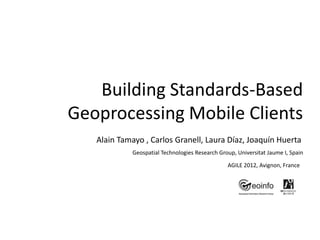Building Standards-Based Geoprocessing Mobile Clients
- 1. Building Standards-Based Geoprocessing Mobile Clients Alain Tamayo , Carlos Granell, Laura DĂaz, JoaquĂn Huerta Geospatial Technologies Research Group, Universitat Jaume I, Spain AGILE 2012, Avignon, France
- 2. 1 . Introduction OGC standards define a set of web service interfaces and encoding formats to exchange geospatial information: maps, geographical features, satellite imagery, etc. Most of the protocols are based on XML for textual data. XML The structure of the data is defined using XML Schema
- 3. 1 . Introduction The Web Processing Service (WPS) specification aims to expose any kind of (geospatial) processes as web services. In contrast to other OGC specifications, WPS presents an additional challenge as providers may define their own input and output data encodings formats.
- 4. 1. Introduction Mobile devices have had a rapid evolution making it possible for users to access Web content anytime, anywhere. The main drawback of mobile devices is battery life. 4
- 5. 2. Problem Geospatial applications based on OGC specifications have not had a wide adoption on mobile devices. • Complexity of schemas • Potential large size of transferred information 5
- 6. 3 . Complexity Type Definition Hierarchy GML 2.0.0 Type Definition Hierarchy GML 3.1.1 6
- 7. 3. Complexity Schema Types Dependencies GML 2.0.0 Schema Types Dependencies GML 3.1.1 7
- 8. 4. Pragmatic solutions • Reuse of existing libraries • Advantages: reduced implementation cost • Disadvantages: • Not many WPS libraries available, and even less that can be executed in a mobile device • XML data binding tools • Advantages: enhanced productivity • Disadvantages: • Structure of generated code do not match the structure of your classes • Code with large size, not suited for mobile devices 8
- 9. 5. Goal • Build a framework that simplifies the development of WPS mobile clients: • Communication library supporting the basic network level data exchange • A code generator that allows to generate compact code for XML-based exchanged messages 9
- 10. 6 . Network Communication Library • Optimized to have the minimum possible size: • Support only mandatory bindings of operations • Prefer RawDataOutput to ResponseDocument as output response • Customized outgoing message packaging (template-based serialization)
- 11. 7 . Code Generator • Use of XML documents to determine how schemas are used by the application (Instance-based data binding [Tamayo et al, 2011]) • Disabling parsing or serialization operations as needed • Ignoring sections of the instance files • Use of streaming APIs for low-level XML manipulation [Tamayo et al, 2011] A. Tamayo, C. Granell, and J. Huerta. Instance-based XML data binding for mobile devices. In Proceedings of the 3rd International Workshop on Middleware for Pervasive Mobile and Embedded Computing, M-MPAC’2011, 2011
- 12. 8. Instance-based XML data binding Assumptions: - Actual implementations do not use the whole specification schemas. - A set of representative XML documents is available to drive the schema simplification process.
- 13. 9. Sample applications 13
- 14. 10. Limitations and Challenges • Limitations: • Only GML-Packet schema in 52 North WPS server supported in Execute requests • Only synchronous requests are supported • Challenges: • Sheer size of XML schemas • Exchange of large volumes of data (binary formats?) [Tamayo et al, 2011] A. Tamayo, C. Granell, and J. Huerta. Instance-based XML data binding for mobile devices. In Proceedings of the 3rd International Workshop on Middleware for Pervasive Mobile and Embedded Computing, M-MPAC’2011, 2011
- 15. 11. Conclusions • We have presented the WPS Mobile Framework (WMFW), that allows building customized WPS clients targeted to mobile devices. • The framework provides a light-weight communication layer and customized XML data binding code generation that produces binary code with a low memory footprint and acceptable performance.
- 16. Âż? Thank you for your attention










![7 . Code Generator
• Use of XML documents to determine how schemas are
used by the application (Instance-based data binding
[Tamayo et al, 2011])
• Disabling parsing or serialization operations as needed
• Ignoring sections of the instance files
• Use of streaming APIs for low-level XML manipulation
[Tamayo et al, 2011] A. Tamayo, C. Granell, and J. Huerta. Instance-based XML data binding for mobile devices. In Proceedings of the 3rd
International Workshop on Middleware for Pervasive Mobile and Embedded Computing, M-MPAC’2011, 2011](https://image.slidesharecdn.com/presentation-120606025230-phpapp01/85/Building-Standards-Based-Geoprocessing-Mobile-Clients-11-320.jpg)


![10. Limitations and Challenges
• Limitations:
• Only GML-Packet schema in 52 North WPS server
supported in Execute requests
• Only synchronous requests are supported
• Challenges:
• Sheer size of XML schemas
• Exchange of large volumes of data (binary formats?)
[Tamayo et al, 2011] A. Tamayo, C. Granell, and J. Huerta. Instance-based XML data binding for mobile devices. In Proceedings of the 3rd
International Workshop on Middleware for Pervasive Mobile and Embedded Computing, M-MPAC’2011, 2011](https://image.slidesharecdn.com/presentation-120606025230-phpapp01/85/Building-Standards-Based-Geoprocessing-Mobile-Clients-14-320.jpg)

